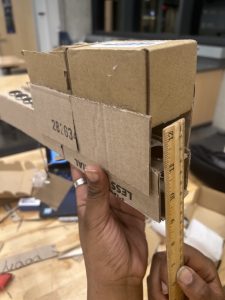Risks:
Stability: We still have some work to do on finalizing the length and other components when it comes to stability, but our whole project focuses on whether the carrier could levitate smoothly while traveling around the track. This poses a huge risk to us and really determines whether or not we can continue making progress on our project, as well as adding a risk to meet our new proposed MVP. When working on the cardboard prototype, we realized that whenever we placed our carrier on the track, the carrier would jump off the track to the side. We kept altering the thicknesses and the length of the sides on the carrier. We looked into increasing the length of the carrier itself which seemed to help out a bit alongside the new lengthened sides. We have also discussed altering the design of the support system on the carrier as well as the actual track itself to allow for more support and canceling any chances of the carrier jumping off as previously stated. If our plans for stability don’t meet our expectations, we can pivot into altering the support portion of the carrier, i.e. having wheels ride along the track instead of lengthened sides.
Propulsion: Another risk we can encounter for this project is making sure our H-Bridge and Arduino work perfectly with each other to allow for propulsion across the track. This system affects the speed of the carrier and whether the carrier would be able to move at all. This poses a huge risk because as previously stated, any failures of the H-Bridge or the Arduino could mean that we would only have a levitating carrier but it wouldn’t be able to move. Of course we could simply push the carrier across the track but we want our product to stand out to the existing market, thus making this an even more important task. We can look into buying alternative H-Bridge chips and Arduinos if the ones we have doesn’t function as expected, but overall we could look into pivoting towards a mechanical wheel system which would implement some sort of battery or motor for the carrier.
Design Changes:
- Carrier will be redesigned to have a greater length to help with stability when levitating. With a shorter carrier, there were issues with the carrier rotating on its side and slipping off the track. The carrier’s legs will be thicker and filled in and not hollowed out as shown in the design review presentation, the thicker legs will help with sturdiness as the legs broke after 3D printing.
- The track will be redesigned to have grooves where the carrier will contact to ensure greater security when the carrier is moving along the track, and make sure the carrier doesn’t lean awkwardly to one side.
- With both design changes, the only cost will be extra time allocated for additional CAD design and the actual 3D printing. Cost is not severe enough for mitigations.
Cardboard prototype with levitation
updated schedule


